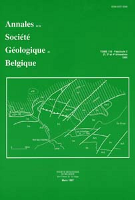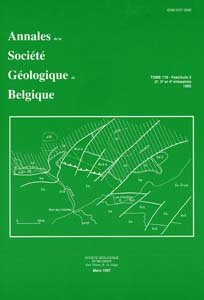- Accueil
- Publications spéciales = special publications
- Géologie des domaines cristallins - Centenaire de ...
- Some aspects of the early Precambrian geology of the Pentevrian basement of the Channel Isles and the Cotentin, Armorican Massif
Visualisation(s): 383 (0 ULiège)
Téléchargement(s): 68 (0 ULiège)
Some aspects of the early Precambrian geology of the Pentevrian basement of the Channel Isles and the Cotentin, Armorican Massif

Abstract
Gneisses form the southern part of the island of Guernsey and parts of the La Hague peninsula, west of Cherbourg, France. Adams (1967) obtained a Rb/Sr whole rock isochron date of around 2 600 m.yr. for the granitic gneisses of Guernsey and Leutwein et al. (1973) have found a similar date for certain of the gneisses of La Hague. Thus these rocks provide an opportunity to study some of the oldest geological events so far recorded from Western Europe.
The gneisses of La Hague were formed in large part from a series of sediments. The earliest structure preserved in the gneisses and in semi-pelitic enclaves is a fine scale lithological lamination (S0). This was folded during an early deformation (D1)and a gneissose banding (S1) produced. A second deformation (D2) transposed the S1gneissose banding parallel to the main foliation (S2) in the gneisses. Evidence for these two separate deformations includes the presence of small scale fold hinges defined by S1banding within the S2foliation, a lineation formed by intersection of S1by S2and rare small scale interference structures produced by D2folding of D1folds. No large scale structures may be traced because of limited inland exposure.
Relict andalusite and garnet preserved within less deformed portions of the S1gneissose banding suggest an early low pressure amphibolite facies metamorphism accompanying D1 . Andalusite pseudomorphs have been overgrown by the S2foliation and mineral assemblages including sillimanite, almandine and muscovite indicate upper amphibolite facies metamorphism during D2 .
Quartz dioritic and granodioritic bodies cut the S2foliation at Nez de Voidries and Nez de Jobourg. However, D2stresses were still sufficient to produce a foliation in these bodies. A third deformation (D3) gave rise to small asymmetric folds. This may have been preceded and was certainly followed by the intrusion of basic dykes. All these events pre-date the intrusion of a suite of foliated granitic rocks, the Thiebot complex, which may be of early Cadomian age as suggested by an imprecise Rb/Sr whole rock isochron (Leutwein et al., 1973).
On Guernsey the oldest rocks are metasediments which occur as screens both within and at the margins of the granitic Icart gneiss. The metasediments contain a mineral assemblage including cordierite and andalusite. This was formed during the first deformation D1which produced a gneissose banding (S1)in the Icart gneiss. The S1banding was deformed during a second deformation (D2) giving rise to the main foliation in the gneisses under amphibolite facies conditions. The Perelle and Doyle quartz dioritic gneisses were emplaced and foliated close to this time. A third deformation (D3) produced large scale refolding of S2and a very local development of a new foliation under upper greenschist facies conditions.
The close similarity in the geological history of the two areas of gneisses suggests that they formed part of the same Precambrian gneiss series.





